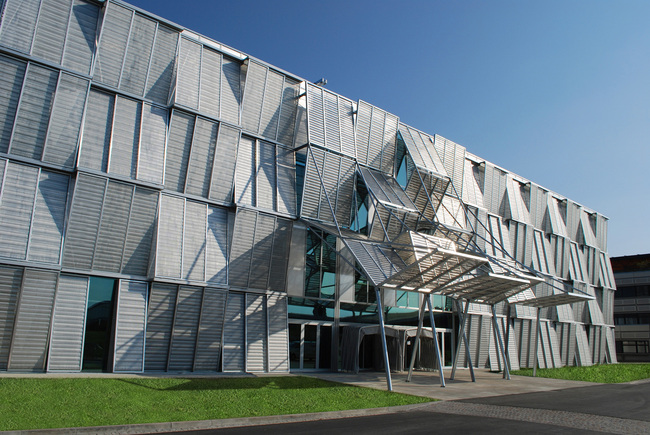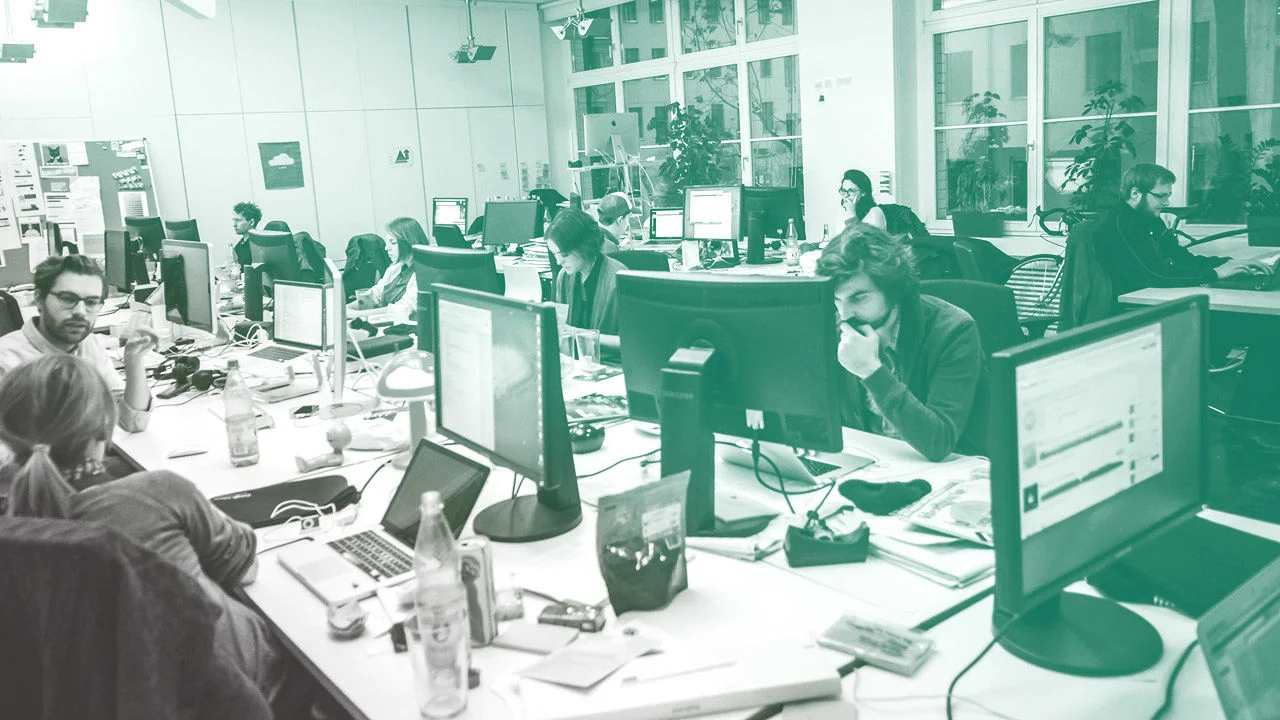Coworking spaces are on the rise, from Google’s “Campus” in London to NextSpace in California. Much has been made of these shared workspaces as a brand-new idea, one that barely existed 10 years ago. But the way they function reminds me of a very old idea: the Renaissance “bottega” (workshop) of 15th-century Florence, in which master artists were committed to teaching new artists, talents were nurtured, new techniques were at work, and new artistic forms came to light with artists competing among themselves but also working together.
DESIGN INSPIRATION FROM SALONE DE MOBILE
Baillie Davis, industrial designer in the Coalesse Design Group, recently traveled to Milan, Spain, to attend Salone de Mobile. The annual furniture fair is one of the largest in the world and draws more than 300,000 visitors each year. With more than 1,300 furniture and furnishing accessories vendors, the event is full of inspiration.
Workplace stress ‘a collective challenge’ as work-life boundaries become blurred – UN
Marking World Day for Safety and Health at Work, the United Nations’ International Labour Organization (ILO) today outlined the findings of its latest research on the impact of stress in the workplace.
The digital future of work is more about humans than machines, claims study
The claims that robots will render the human species redundant are largely exaggerated suggests a new report from Cognizant’s Centre for the Future of Work and the Economist Intelligence Unit. But we will have to find a new path and it may be one that emphasises human strengths and characteristics working alongside robots. The study of 420 managers in Europe and the US explores the future of the workplace in an increasingly automated world and suggest we will also see the emergence of new jobs involved in the design of augmented reality and avatars as well as a generally greater emphasis on robot-human partnerships in an increasingly digital world. The study claims, unsurprisingly, that the reliance on physical office space will recede, forcing businesses to employ intelligent workplaces which will monitor workers’ environment, needs and even moods.
New partnership to encourage creation of age friendly workplaces
Between 2005 and 2015 the number of people working over the age of 50 in the UK increased by 2.5 million, while those working over the age of 65 more than doubled. By 2022, there will be 12.5 million job vacancies that need to be replaced due to people leaving the workforce in addition to the two million new vacancies that will be created. However, there are estimated to be just seven million younger people to fill them. Recruiting and retaining older workers will be critical to closing this gap. Now in a major new initiative, the Centre for Ageing Better has gone into partnership with Business in the Community to identify and test what works to recruit, retrain and retain older workers. Through this partnership, it wants to hear from employers across the country who see the benefits of older workers and who are implementing changes to create age friendly workplaces.
Five ways brands can better manage millennials in the workplace
Millennials will account for 50% of the global workforce within the next four years so brands need to understand how to manage them more effectively. That means creating a collaborative environment where people are continually challenged so they don’t get bored and allowing them to take ownership of their development, says Helen Tupper, careers consultant and head of marketing at Virgin Red.
American Students Need Room to Grow
American students need to hit the books. According to the latest international data, the United States ranks 24th among 34 developed countries in math and science achievement – well below countries like Slovenia, Vietnam and the Czech Republic. Our dismal academic performance has real consequences for our economy. If U.S. students were to match the test scores of their Canadian peers – who rank 17 spots higher– the American economy would generate $10 trillion in additional growth during the next 35 years. That’s an average of $285 billion a year.
The Proven Benefits Of Daylighting On Employees And The Environment
There are many benefits produced as a byproduct of incorporating daylighting into an office building design. Access to daylight throughout the day improves employee well-being and overall health, even after leaving the office. Besides creating a pleasant working environment for employees, solar protection also plays a key part in supporting sustainable energy efficiency concepts.
HOW TO IMPROVE COLLABORATION IN AN OPEN OFFICE ENVIRONMENT
There are countless studies detailing how working in an open office affects your employees’ productivity, thanks to elevated noise levels and the constant stream of interruptions. In a bid to improve productivity and focus, more and more office workers put their headphones on and shut out the noise – and their colleagues – hindering the collaborative environment the open office was designed to foster.
A WORKPLACE THAT DOUBLES AS A WELLNESS SPACE: THE NEXT BIG THING?
Is having a yoga studio, meditation classes, and fresh smoothies in your office going to be commonplace in the near future? Two former staffers at WeWork—the coworking mega-company valued at $16 billion—think so, and they’re making that endorphin-boosting dream a reality in New York City.
Can Workplace Wellness Help the Environment?
Healthcare in America is some of the best you can receive in the world, but the healthcare system is not without its costs. One such cost that has begun to receive added attention in recent years is the environmental footprint of the estimated 5,000 hospitals in the United States. According to the Journal of the American Medical Association, these facilities produce huge volumes of waste (as much as 7,000 tons per day), and account for 8% of America’s carbon emissions.
How Telecommuting is Shaping the Modern Office
Telecommuting is on the rise. And with more and more work done online, it’s hardly surprising. Who wouldn’t want to skip the morning commute and work from the comfort of home? But not everybody is happy about the shift—especially office landlords, who are adapting to the trend by rethinking office layouts and searching for the best ways to stay competitive while giving modern tenants what they're looking for.
5 Ways to Create a More Productive Workspace
Ever notice your members restless and distracted after lunch or early in the afternoon? Does your community manager notice mindless typing, distracted members, many getting up and sitting down and then getting up again? Though many a time internal factors such as lack of sleep or overeating lead to this kind of behavior, truth is that environmental factors also contribute to them. Which is why it’s important for your workspace to be inviting and encouraging. Think of it this way: when you’re in a room that’s too hot or too cold, that is noisy, and has bright colors you can’t sleep well – you don’t feel rested. Well, same goes for the workspace; the same factors in a room that can influence or deter sleep can also drive or deter productivity.
How to Make Work Healthier: Move It!
How sedentary is your work? If you’re like many office workers, you probably wish you could be more active, maybe spend less time sitting. But, work keeps most of us at our desks. We may have a cell phone, maybe a tablet or laptop, so you’d think we could be fairly mobile. But most workers aren’t.
Productivity and the Workplace of the Future
The way we work changes rapidly. The intersection of technology and architecture offers a glimpse into the workplace of the future. A typical workday no longer resembles a worker sitting in rush hour traffic for an hour, and then at a cubicle for eight more. Advances in workplace architecture and emerging technologies are changing the face of the work environment. These changes are having positive effects on productivity.
Why Your Office Space Matters More for Productivity Than You Think
What's the relationship between quality of office space and company performance in tech companies? originally appeared on Quora - the knowledge sharing network where compelling questions are answered by people with unique insights.
Gen Y's Number One Most Basic Need In The Workplace
When asked what millennials need in the workplace, I struggle to answer concisely. Because it’s many things. It’s competency; it’s mentorship; it’s flexibility; it’s training; it’s clearly-outlined objectives; it’s independence. I didn’t realize that these desires had an overarching theme until I studied attachment theory, which suggests that our relationship styles are formed in childhood with enduring, pervasive consequences.
Is Your Job Making You Fat?
How much did you weigh when you started your current job? And what do you weigh now? Forgive the personal questions but, if you’re anything like the 3,000 full-time employees in a new CareerBuilder survey, you’ve noticed that you’ve put on at least a few pounds—and you’re not thrilled about it.
How to "Hack" Workplace Design
On the evening of March 24th, Metropolis publisher and editor in chief, Susan S. Szenasy, arrived at the iconic, postmodern Lipstick Building to moderate and lead the State of Design: Where We Work panel, hosted by Meadows Office Interiors in their Manhattan showroom. The panelists—Kelly Funk, senior workplace strategist, IA Interior Architects; Adrian Parra, director of marketing for North America, Vitra; and Randall A. Whinnery III, senior director of design, Fidelity Real Estate Co.—tackled the topic of office design, specifically, how to “hack” workplace design.
5 Ways Every Company Can Embrace Startup Culture (Without Overdoing It)
In 2014, I served as executive vice president for Cricut, a small company that manufactures personal electronic cutting machines for creative design. At the time, the company was struggling. Once an industry leader, it was being outpaced by competitors, and it was my job—along with senior management's—to turn things around. We needed to do more than rebrand; we needed to think and act more like a startup. That's a familiar solution to a familiar problem that once dominant companies face. Earlier this year, Samsung announced a major push to reinvent its culture in the startup mold. That isn't easy to pull off, though, and unfortunately, our initial changes at Cricut fell flat.

























